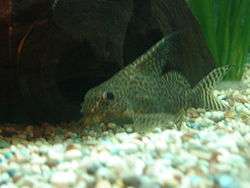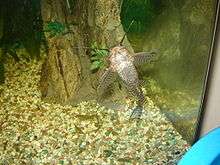Featherfin squeaker
| Synodontis eupterus (featherfin synodontis) | |
|---|---|
| | |
 | |
| Scientific classification | |
| Kingdom: | Animalia |
| Phylum: | Chordata |
| Class: | Actinopterygii |
| Order: | Siluriformes |
| Family: | Mochokidae |
| Genus: | Synodontis |
| Species: | S. eupterus |
| Binomial name | |
| Synodontis eupterus Boulenger, 1901 | |
The featherfin squeaker (Synodontis eupterus) or featherfin synodontis is a species of Synodontis catfish. This species is found in the basins of the White Nile, Volta and Niger Rivers and the Chad Basin. Also known simply as featherfin catfish. Featherfin squeakers are called such due to their ability to make noises to communicate with one another and also for their high feather-like fin which is valued by many hobbyists. Wild specimens can grow to a length of 30.0 centimetres (11.8 in) SL.
In the aquarium
.jpg)
General information
Featherfin squeakers are a fun fish to have, but difficult to care for., and are great additions to community tanks that house larger fish. Just like with any other bottom dwellers be sure not to overcrowd as this may result in territorial disputes. The addition of caves and branched driftwood will allow for more patrol surfaces and several featherfin can be housed together. As with any fish, the tank water should always be clean and at a balanced pH (7-8.5), kH of 2–15 and a warm water temperature, around 72 to 80 °F. The absolute minimum tank size should be 30 gallons (110 L), with some large enough caves for the synodontis to hide in. Sometimes, like its cousin the Upside Down Catfish (Synodontis nigriventris), it may turn upside down in order to get food. This will usually only happen when it is resting.
Description
The featherfin squeaker is a fish for long time aquarists. It is a fun fish to have, but difficult to care for. It gets its name from the wonderful dorsal fin, which rays out, much like a fan. While not always true, the featherfin squeaker can require a lot of work to maintain. Featherfin squeakers, in general, will not like to share a tank with other fish. They have been known to be very territorial, especially when breeding. There are fish that they might be able to coexist with, however. These include large African Cichlids, as they are equally aggressive. Also, they will sometimes get along with other catfish. Featherfin squeakers get large, so keep them in large tanks. Also, they like lots of rocks and caves to hide in, as well as moderate plant decoration. Featherfin squeakers like live plants, and will not bother them. At maturity, they will grow to a size from five to eight inches. Also, these fish have long life spans. There have been reports of these fish living for 28 years. Young featherfin squeakers will have a brown marble with black stripes pattern, while adults will develop into a dull gray color with brown spots. As mentioned before, the featherfin squeaker has a beautiful dorsal fin, which rays out, much like a fan.
Diet
These are omnivorous and should be given a good quality flake food as the staple, or sinking catfish pellets. An occasional feeding of spirulina flakes or algae wafers would ensure the vegetable part of their diet. Once weekly feeding of bloodworms, tubifex, brine shrimp and other meaty foods will complete the perfect diet. They should be fed just before the lights are turned off, because, like most catfish, it is nocturnal.
Tankmates
These bottom dwelling Synodontis catfish should have their own territories. Reports have been made that it is kept successfully with Corydoras catfish, plecostomus, Geophagus, gouramis, and is said to be a perfect bottom dweller for rift lake cichlid aquariums. In some African cichlid tanks the other inhabitants may nibble the long dorsal streamers of the catfish.
Breeding
Synodontis eupterus has never been bred naturally in captivity, so there is a likelihood that pet shop specimens were bred from hormone injected parents, which is not readily available or recommended for an inexperienced hobbyist to accomplish.
References and sources
References
- ↑ Awaïss, A.; Getahun, A. & Lalèyè, P. (2010). "Synodontis eupterus". IUCN Red List of Threatened Species. Version 2013.2. International Union for Conservation of Nature. Retrieved 25 May 2014.
Sources
- "Synodontis eupterus Featherfin Squeaker (Catfish)". aquahobby.com.
- "Featherfin Catfish". Aquarium Life.
- Froese, Rainer and Pauly, Daniel, eds. (2014). "Synodontis eupterus" in FishBase. May 2014 version.
- "Synodontis eupterus Boulenger, 1901". PlanetCatfish.
External links
| Wikimedia Commons has media related to Synodontis eupterus. |
| Wikispecies has information related to: Synodontis eupterus |

